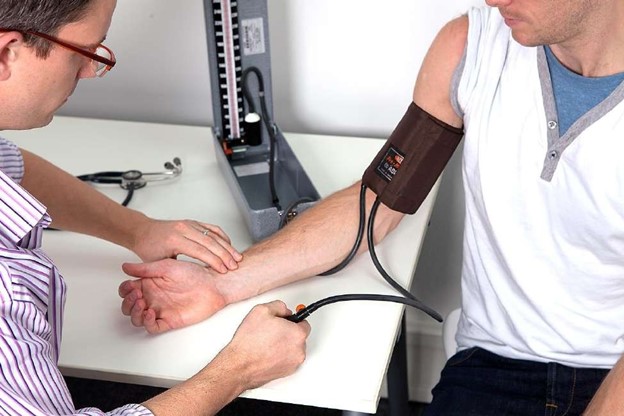A nurse is obtaining a client’s manual blood pressure and is having difficulty auscultating sounds.
Which of the following actions should the nurse take?
Apply the largest cuff available.
Use the palpatory method to determine blood pressure.
Place the arm above the level of the client’s heart.
Deflate the cuff quickly.
The Correct Answer is B
This method involves feeling the radial pulse while inflating and deflating the cuff.

The systolic pressure is estimated by noting the pressure at which the pulse disappears and reappears. The diastolic pressure is not measured by this method, but it can be useful when the sounds are difficult to hear.
Choice A is wrong because applying the largest cuff available can result in a falsely low reading. The cuff size should be appropriate for the client’s arm circumference.
Choice C is wrong because placing the arm above the level of the client’s heart can also cause a falsely low reading. The arm should be at the level of the heart for an accurate measurement.
Choice D is wrong because deflating the cuff quickly can lead to missing or skipping sounds, resulting in an inaccurate reading. The cuff should be deflated slowly and evenly.
Normal ranges for blood pressure vary depending on age, sex, and health conditions, but generally, a systolic pressure below 120 mmHg and a diastolic pressure below 80 mmHg are considered normal for adults.
Nursing Test Bank
Naxlex Comprehensive Predictor Exams
Related Questions
Correct Answer is C
Explanation
This is because the eyes of a deceased client do not close naturally and may remain open after death. Holding them shut for a few seconds helps to keep them closed and prevent drying of the corneas. This also gives a more peaceful appearance to the client’s body for the family visit.
Choice A is wrong because crossing the client’s arms across their chest is not a standard postmortem care procedure. It may also interfere with the placement of identification tags on the wrists.
Choice B is wrong because placing the client in a high-Fowler’s position is not necessary or appropriate for postmortem care. The client should be placed in a supine position with the head of the bed elevated to prevent livor mortis (purple discoloration of the skin) on the face.
Choice D is wrong because removing the client’s dentures from their mouth is not recommended for postmortem care. The dentures should be left in place to maintain the shape of the face and prevent the jaw from dropping.
Normal ranges are not applicable for this question as it does not involve any physiological measurements.
Correct Answer is D
Explanation
Herpes zoster is a contraindication for receiving acupuncture treatment because it is an infectious skin disorder that can be transmitted by needles or contact with the affected area. Acupuncture should not be performed on areas of skin that are inflamed, ulcerated, or have sensory deficits.
Choice A is wrong because hypertension is not a contraindication for acupuncture. However, some caution is advised when needling points that may lower blood pressure, such as LI 4, LI 11, ST 36, and SP 6.
Choice B is wrong because hypothyroidism is not a contraindication for acupuncture. In fact, some studies suggest that acupuncture may have beneficial effects on thyroid function and symptoms of hypothyroidism.
Choice C is wrong because obesity is not a contraindication for acupuncture.
Acupuncture may help with weight loss by regulating appetite, metabolism, and hormones.
Some of the absolute contraindications for acupuncture include pregnancy (especially certain points that may induce labor or abortion), medical and surgical emergencies, malignant tumors, bleeding disorders, and the use of a demand pacemaker. Some of the relative contraindications include drug or alcohol intoxication, lack of consent, immune deficiency, abnormal heart valves, and fear of needles.
Normal ranges for blood pressure are 120/80 mmHg or lower for systolic and diastolic pressure respectively.
Normal ranges for thyroid-stimulating hormone (TSH) are 0.4 to 4.0 mIU/L. Normal ranges for body mass index (BMI) are 18.5 to 24.9 kg/m2.
Whether you are a student looking to ace your exams or a practicing nurse seeking to enhance your expertise , our nursing education contents will empower you with the confidence and competence to make a difference in the lives of patients and become a respected leader in the healthcare field.
Visit Naxlex, invest in your future and unlock endless possibilities with our unparalleled nursing education contents today
Report Wrong Answer on the Current Question
Do you disagree with the answer? If yes, what is your expected answer? Explain.
Kindly be descriptive with the issue you are facing.
